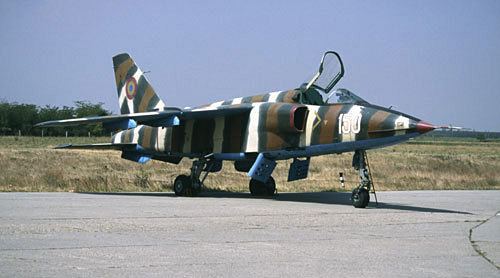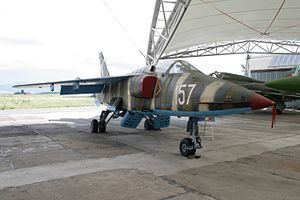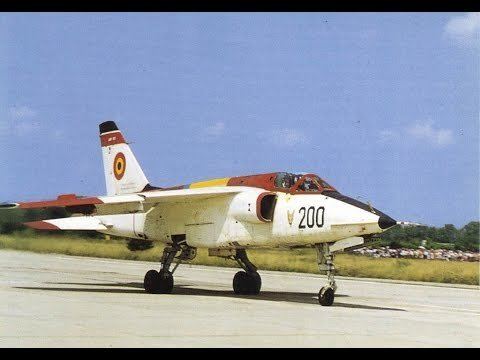Top speed 1,089 km/h Length 15 m First flight October 31, 1974 | Wingspan 9.3 m Engine type Armstrong Siddeley Viper Number of seats 2 | |
The Avioane Craiova IAR-93 Vultur (Vulture) is a twin-engine, subsonic, close support, ground attack and tactical reconnaissance aircraft with secondary capability as low level interceptor. Built as single-seat main attack version or combat capable two-seat version for advanced flying and weapon training, it was developed as a joint Yugoslav-Romanian project in the 1970s for the air forces of both nations. The Romanian aircraft were built by I.R.Av. Craiova as IAR-93, and its Yugoslav counterpart by Soko as the Soko J-22 Orao. For Romania, the IAR-93 was intended to replace MiG-15s and MiG-17s in the fighter-bomber role.
Contents
- Development
- Flight testing
- Variants
- Operators
- Lost aircraft
- Retirement
- Aircraft on display
- Specifications IAR 93B
- References

Development
On May 20, 1971, Romania and Yugoslavia signed the governmental agreements for the YuRom R&D programme. The program managers were Dipl. Dr. Engineer Teodor Zamfirescu for the Romanian party and Colonel Vidoje Knežević for the Yugoslav party.
The requirements called for a light subsonic aircraft for ground attack and tactical reconnaissance missions and with low level air combat as a secondary capability. It was to be built on a simple structure, using locally produced equipment and avionics (but compatible with western components), tough (able to operate on grass or damaged runways), easy to maintain and reliable. The aircraft was of conventional twin-engine, high mounted wing monoplane configuration with all flying surfaces swept. The Rolls-Royce Viper was chosen as the powerplant, as SOKO had experience with licence-building this engine. It was originally intended that an afterburner would be developed for the Viper engines, but there were prolonged difficulties with this project, meaning that none of the pre-production aircraft featured it, and neither did early production examples. During the 1980s, both countries developed slightly different versions to take advantage of the afterburning engines that had since become available.
Flight testing

The Romanian single-seat prototype White 001 made its first flight which lasted 21 minutes on October 31, 1974 at Bacău (simultaneously with the Yugoslav prototype at Batajnica Air Base). The aircraft was flown by Colonel Gheorghe Stănică. On September 20, 1979 the plane was lost when, during a test flight both engines stopped and the pilot ejected. This prompted modifications to the combustion chamber (including all aircraft already delivered).
On July 18, 1975 the aircraft was presented to Nicolae Ceauşescu on the Bacău airfield.

The DC (two-seat) prototype #003 first flew on January 23, 1977, and was lost on November 24, 1977 due to tail flutter. The left elevator broke off while in level flight at 500 m altitude and 1,045 km/h. The Martin-Baker Mk RU10J zero-zero ejection seats functioned well and the two test pilots ejected safely. After this event the aft fuselage structure was reinforced.

Prototype #004 crashed at Craiova Air Base on February 20, 1979 during an aerobatics demonstration. The pilot, Capt. Eng. Dobre Stan didn't manage to eject.
On August 23, 1979 three IAR-93 (#001, #002 and #005) were first presented to the public in flight during the military parade celebrating the national day of Romania at that time.
Variants
15 pre-production aircraft delivered in 1979; entered service in 1981
26 built (#109-119 pre-production, #150-164 series) as single-seaters and 9 DC (two-seat) trainers (#005-008 pre-production, #180-184 series)
delivered starting with 1982
15 single-seaters built (#201-215)
first flew in 1985; entered service in 1987
27 built as single-seater (#200, #216-241) and 7 DC (#600-606)
Operators
Lost aircraft
Data from Romanian press and partially from ejection-history.org.uk
Retirement
Following the outbreak of the war in Yugoslavia and the UN embargo, the IAR-93 program ended in Romania in 1992, with several airframes in different stages of construction. Around 75 aircraft were still in service, a few of them being used for testing and research (#200 - first B model with afterburners, #600 (DC) - the only one fitted with canards).
The last IAR-93s were withdrawn and mothballed from the Romanian Air Force in 1998. Surviving airframes are stored at Deveselu (IAR-93A #116), Timisoara (IAR-93MB #214), and Craiova (about 60 aircraft), not flight worthy (engines and other equipment removed) and most of them are up for sale. Apparently 20 of them were scrapped until 2006, with the rest awaiting the same fate in 2007.
The J-22 Orao are still in service with the air force of Serbia. The last Yugoslav aircraft was delivered in February 1992, and the plant in Mostar was destroyed shortly after.
Aircraft on display
Specifications (IAR-93B)
Data from Avioane Craiova SA, INCAS
General characteristics
Performance
Armament
Avionics
